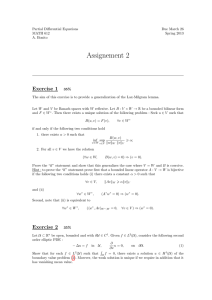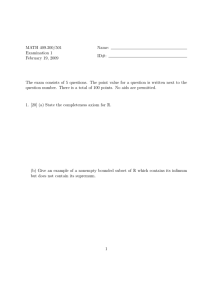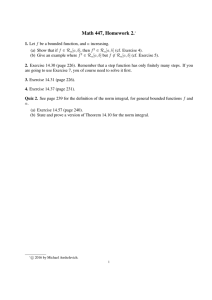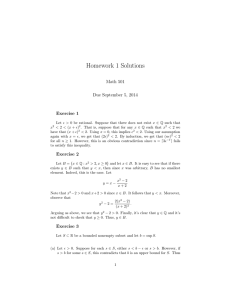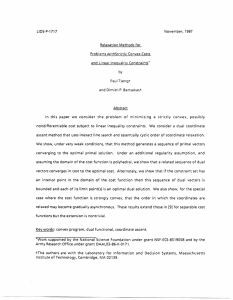Homework 1 Math 501 Due September 5, 2014 Exercise 1
advertisement
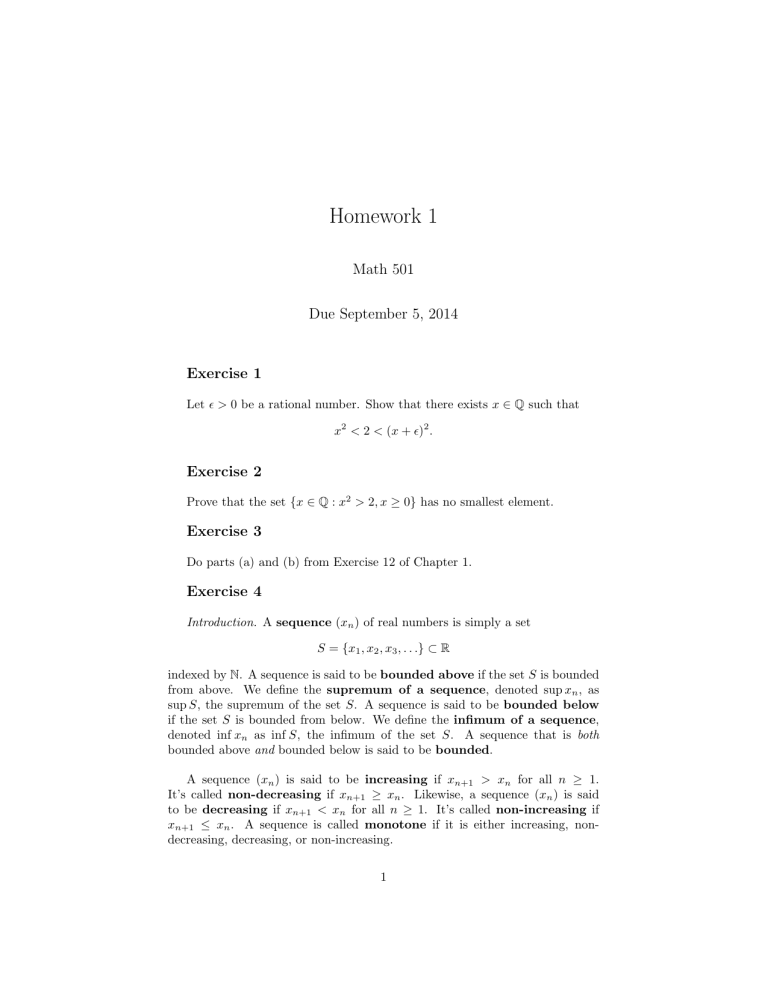
Homework 1
Math 501
Due September 5, 2014
Exercise 1
Let > 0 be a rational number. Show that there exists x ∈ Q such that
x2 < 2 < (x + )2 .
Exercise 2
Prove that the set {x ∈ Q : x2 > 2, x ≥ 0} has no smallest element.
Exercise 3
Do parts (a) and (b) from Exercise 12 of Chapter 1.
Exercise 4
Introduction. A sequence (xn ) of real numbers is simply a set
S = {x1 , x2 , x3 , . . .} ⊂ R
indexed by N. A sequence is said to be bounded above if the set S is bounded
from above. We define the supremum of a sequence, denoted sup xn , as
sup S, the supremum of the set S. A sequence is said to be bounded below
if the set S is bounded from below. We define the infimum of a sequence,
denoted inf xn as inf S, the infimum of the set S. A sequence that is both
bounded above and bounded below is said to be bounded.
A sequence (xn ) is said to be increasing if xn+1 > xn for all n ≥ 1.
It’s called non-decreasing if xn+1 ≥ xn . Likewise, a sequence (xn ) is said
to be decreasing if xn+1 < xn for all n ≥ 1. It’s called non-increasing if
xn+1 ≤ xn . A sequence is called monotone if it is either increasing, nondecreasing, decreasing, or non-increasing.
1
The problem, part 1. Prove that any increasing sequence that is bounded
above converges.
The problem, part 2. Is there a corresponding statement for decreasing
sequences?
Hint for part 1. Here’s one approach: first take a guess at what the sequence
should converge to. Then, using your guess, prove convergence directly from
the definition. You’ll probably want to use the previous exercise at some point.
Exercise 5
Introduction. Let (xn ) ⊂ R be a sequence of real numbers. Given an increasing sequence of natural numbers (nk ) = {n1 , n2 , n3 , . . .} ⊂ N, we define a
subsequence of (xn ) to be the subset (xnk ) ⊂ (xn ) indexed by (nk ).
Lemma. Every sequence (xn ) ⊂ R of real numbers has a monotone subsequence.
Start of the proof of the lemma. Let (xn ) ⊂ R be a sequence. We call
n ∈ N a peak of this sequence if xm < xn for all m > n. Now there are two
possibilities. Either (xn ) has infinitely many peaks n1 < n2 < n3 < · · · , or
(xn ) has finitely many peaks. In the first case of infinitely many peaks, the
subsequence xn1 , xn2 , xn3 , . . . is clearly a decreasing subsequence. In the case of
finitely many peaks . . .
The problem, part 1. Complete the proof of the lemma.
The problem, part 2. Prove that every bounded sequence (xn ) ⊂ R of real
numbers has a convergent subsequence.
Exercise 6
Prove that the sequence given by
xn =
n
X
1
k2
k=1
converges by showing that it is a Cauchy sequence.
2

